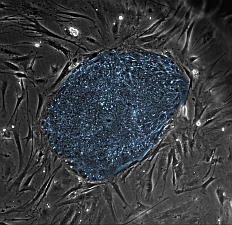Early results from two clinical trials show the safety of retinal cells derived from human embryonic stems cells (hESCs) to treat chronic eye diseases. The results from two patients, one in each trial conducted by the biotechnology company Advanced Cell Technology (ACT) in Marlborough, Massachusetts, were published online in the journal The Lancet.
The clinical trials are testing the safety of transplanting retinal pigment epithelium (RPE) cells generated from hESCs as treatments for Stargardt’s macular dystrophy (SMD) and dry age-related macular degeneration (dry AMD). SMD, also known as juvenile onset macular degeneration occurs in approximately one in 10,000 children, and begins to damage both eyes somewhere between the ages of 6 and 20, leading to severe vision loss or blindness. Dry AMD occurs when the light-sensitive cells in the macula slowly break down, gradually blurring central vision in the affected eye. Over time, as less of the macula functions, central vision is gradually lost in the affected eye.
Before administration, the cells were confirmed to be free of animal and human pathogens, and a high-sensitivity assay was also performed to rule out the presence of any undifferentiated hESCs in the final product, a risk factor for tumor formation. Four months after the treatments were administered at UCLA’s Jules Stein Eye Institute, the two patients showed no signs of rapid cell proliferation, extra tissue formation, or immune-related rejection.
While the trials focused on safety and tolerability, the results with the two patients also showed structural evidence confirming that the hESC-derived cells survived and continued to persist during the study period. Both patients had measurable improvements in their vision that persisted for more than four months.
Both the SMD and dry AMD patients received subretinal transplantation of the smallest dose (50,000 cells) of fully-differentiated RPE cells derived from hESCs. ACT says each trial will eventually enroll 12 patients, with groups of three patients each receiving higher dosages.
Read more: FDA Clears Stem Cell Trial for Macular Degeneration
* * *


 RSS - Posts
RSS - Posts
You must be logged in to post a comment.